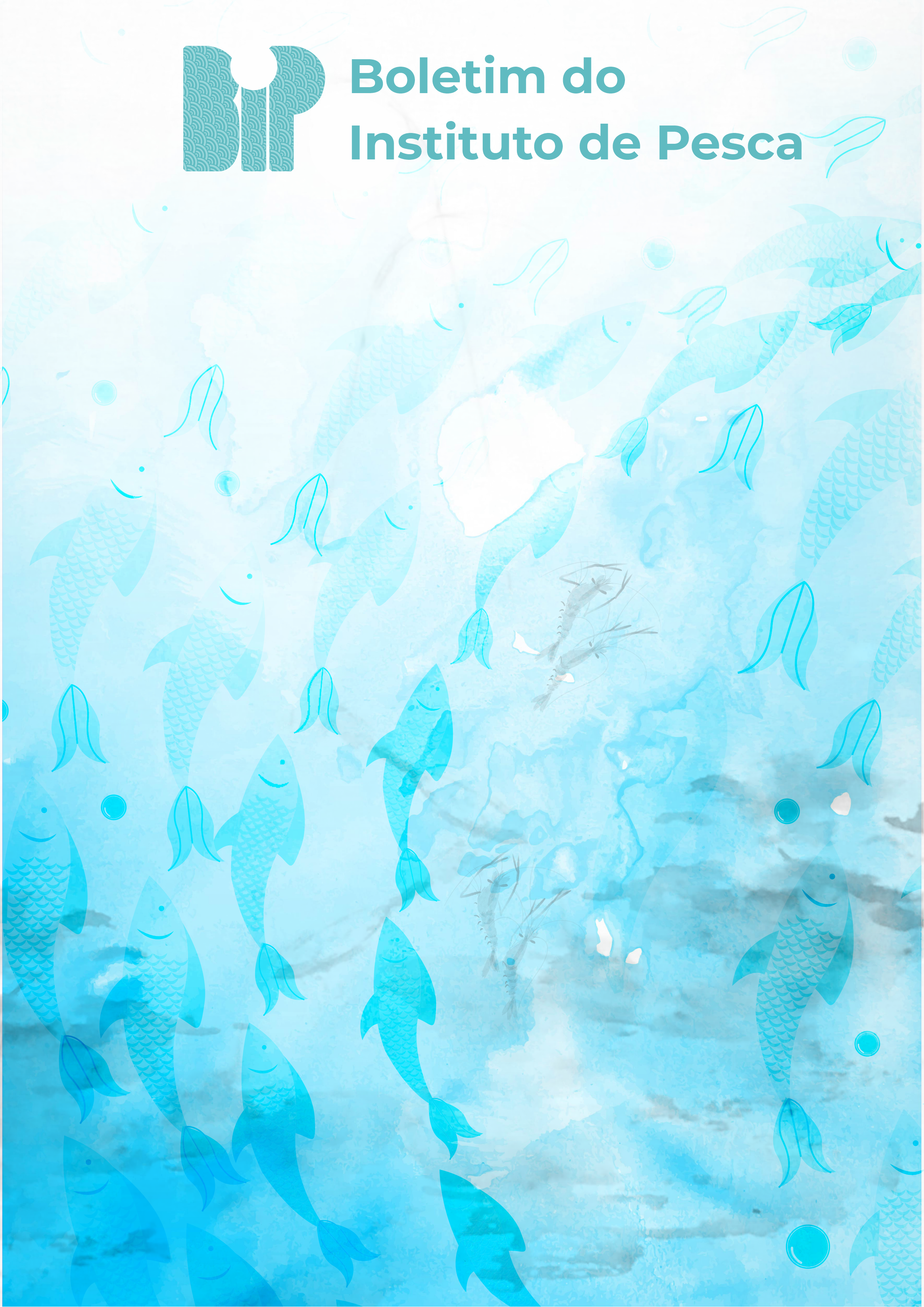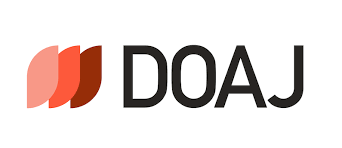Consumo de oxigênio pelo vermelho-dentão em cativeiro: implicações da qualidade da água e do estágio de desenvolvimento do peixe
DOI:
https://doi.org/10.20950/1678-2305/bip.2024.50.e864Palavras-chave:
Respirometria, Água com nitrato, Piscicultura, Estágio de vidaResumo
Respirometria representa o método menos invasivo para investigar a fisiologia de peixes. Sendo assim, o consumo de oxigênio (CO) de vermelho-dentão Lutjanus jocu foi avaliado em duas condições específicas de água de cultivo: água mais limpa possível, e água com acúmulo de nitrato. A água limpa representa a água marinha coletada diretamente do ambiente com um tratamento básico, e a água com nitrato representa a água marinha mantida nos tanques de cultivo usando tratamento avançado da água no sistema de recirculação, em que os compostos nitrogenados acumulam. Os peixes foram classificados em estágios, e as medianas de CO para os estágios juvenil, engorda e reprodutor foram 322,4, 176,5 and 78,4 mg·(kg·h)-1, respectivamente. Apesar de não ter havido diferenças significativas no CO para o vermelho-dentão durante os períodos diurno e noturno, esta última condição representa aumento de 5% nas medições, possivelmente relacionado com o ritmo circadiano da espécie, conhecida por ser ativa durante a noite. Notável aumento da respirometria foi observado no estágio engorda do vermelho-dentão cultivado em água com nitrato. Essa condição demanda gerenciamento extra na produção para promover o bem-estar do peixe e, consequentemente, melhor crescimento.
Referências
Amorim, P.; Sousa, P.; Jardim, E. & Menezes, G.M. (2019). Sustainability Status of Data-Limited Fisheries: Global Challenges for Snapper and Grouper. Frontiers in Marine Science, 6: 654. https://doi.org/10.3389/fmars.2019.00654
Barbieri, E.; Lenz, R.M.; Andrade de Nascimento, A.; Lopes de Almeida, G.; Yoshida Roselli, L. & Barbosa Henriques, M. (2019). Efeito letal e subletal da amônia sobre o Lambari (Deuterodon iguape, Eigenmann 1907), espécie potencial para a Aquicultura Brasileira. Boletim do Instituto de Pesca, 45(1): e440. https://doi.org/10.20950/1678-2305.2019.45.1.440
Beltrán, A.; Vela Magaña, M.A.; Dumas, S. & Peñalosa Martinell, D. (2023). Rearing performance of juvenile yellowtail snapper, Ocyurus chrysurus, in a sea water recirculation system at two different stocking densities. Journal of the World Aquaculture Society, 54(6): 1430-1446. https://doi.org/10.1111/jwas.13007
Bezerra, I.M.; Hostim-Silva, M.; Teixeira, J.L.S.; Hackradt, C.W.; Félix-Hackradt, F.C. & Schiavetti, A. (2021). Spatial and temporal patterns of spawning aggregations of fish from the Epinephelidae and Lutjanidae families: An analysis by the local ecological knowledge of fishermen in the Tropical Southwestern Atlantic. Fisheries Research, 239: 105937. https://doi.org/10.1016/j.fishres.2021.105937
Coniza, E.; Catacutan, M. & Caballero, P. (2012). Growout culture of mangrove red snapper (Lutjan usargentimaculatus Forsskal, 1775) in ponds. Southeast Asian Fisheries Development Center.
Duque-Wilckens, N.; Trainor, B.C.; Marler, C.A. (2019). Aggression and Territoriality. In: Choe J.C. (Ed.). Encyclopedia of Animal Behavior. Elsevier. p. 539-546. https://doi.org/10.1016/B978-0-12-809633-8.90064-5
Engle, C.R.; Kumar, G. & Senten, J. (2020). Cost drivers and profitability of U.S. pond, raceway, and RAS aquaculture. Journal of the World Aquaculture Society, 51: 847-873. https://doi.org/10.1111/jwas.12706
Food and Agriculture Organization (FAO). (2019). The State of the World’s Aquatic Genetic Resources for Food and Agriculture. Rome: FAO. https://doi.org/10.4060/CA5256EN
Garcia Trejo, J.F.; Pena Herrejon, G.A.; Soto Zarazua, G.M.; Mercado Luna, A.; Alatorre Jacome, O. & Rico Garcia, E. (2016). Effect of stocking density on growth performance and oxygen consumption of Nile tilapia (Oreochromis niloticus) under greenhouse conditions. Latin American Journal of Aquatic Research, 44(1): 177-183. https://doi.org/10.3856/vol44-issue1-fulltext-20
Gomez Isaza, D.F.; Cramp, R.L. & Franklin, C.E. (2020). Simultaneous exposure to nitrate and low pH reduces the blood oxygen-carrying capacity and functional performance of a freshwater fish. Conservation Physiology, 8(1): coz092. https://doi.org/10.1093/conphys/coz092
Grimes, C.B. (1987). Reproductive biology of the Lutjanidae: a review. In: Polovina, J.; Ralston, S.; Munro, J.L.; Powers, J.E.; Fox Jr., W.W. (Eds.). Tropical snappers and groupers: biology and fisheries management. Westview Press. p. 239-294.
Hagopian, D.S. & Riley, J.G. (1998). A closer look at the bacteriology of nitrification. Aquacultural Engineering, 18(4): 223-244. https://doi.org/10.1016/S0144-8609(98)00032-6
Hamlin, H.J.; Moore, B.C.; Edwards, T.M.; Larkin, I.L.V.; Boggs, A.; High, W.J.; Main, K.L. & Guillette, L.J. (2008). Nitrateinduced elevations in circulating sex steroid concentrations in female Siberian sturgeon (Acipenser baeri) in commercial aquaculture. Aquaculture, 281(1-4): 118-125. https://doi.org/10.1016/j.aquaculture.2008.05.030
Ibarra-Castro, L.; Ochoa-Bojórquez, M.O.; Sánchez-Téllez, J.L.; Rojo-Cebreros, A.H. & Alvarez-Lajonchère, L. (2020). A new efficient method for the mass production of juvenile spotted rose snapper Lutjanus guttatus. Aquaculture Reports, 18: 100550. https://doi.org/10.1016/j.aqrep.2020.100550
Kim, I.N.; Chang, Y.J. & Kwon, J.Y. (1995). The Patterns of Oxygen Consumption In Six Species of Marine Fish. Korean Journal of Fisheries and Aquatic Sciences, 28(3): 373-381.
León-Ramírez, J.J.; García-Trejo, J.F.; Felix-Cuencas, L.; López- Tejeida, S.; Sosa-Ferreyra, C.F. & González-Orozco, A.I. (2022). Effect of the water exchange rate in a recirculation aquaculture system on growth, glucose and cortisol levels in Oreochromis niloticus. Latin American Journal of Aquatic Research, 50(2): 267-275. https://doi.org/10.3856/vol50-issue2-fulltext-2790
Lisboa, V.; Rodrigues Freire Eloy, H.; Catter, K.M.; Cruz Araújo Bezerra Vidigal, R.; Lelis Muniz Souza, R. & Nogueira Matias, J.F. (2020). Piscicultura marinha brasileira: desafios e perspectivas do seu desenvolvimento no estado do Ceará. Sistemas & Gestão, 15(2): 113-122. https://doi.org/10.20985/1980-5160.2020.v15n2.1636
Malanski E.; Malanski A.C.G.S. & Fernandes L.F.L. (2024). Reproduction of the dog Lutjanus jocu in captivity, linking ecological and production observations. Boletim do Instituto de Pesca, 50 (1) e.878.
Pimentel, C.R. & Joyeux, J.C. (2010). Diet and food partitioning between juveniles of mutton Lutjanus analis, dog Lutjanus jocu and lane Lutjanus synagris snappers (Perciformes: Lutjanidae) in a mangrove-fringed estuarine environment. Journal of Fish Biology, 76(10): 2299-2317. https://doi.org/10.1111/j.1095-8649.2010.02586.x
R Core Team. (2022). R: A Language and Environment for Statistical Computing. R Core.
Rodrigues, R.V.; Schwarz, M.H.; Delbos, B.C.; Carvalho, E.L.; Romano, L.A. & Sampaio, L.A. (2011). Acute exposure of juvenile cobia Rachycentron canadum to nitrate induces gill, esophageal and brain damage. Aquaculture, 322-323: 223-226. https://doi.org/10.1016/j.aquaculture.2011.09.040
Shimura, R.; Ma, Y.X.; Ijiri, K.; Nagaoka, S. & Uchiyama, M. (2004). Nitrate Toxicity on Visceral Organs of Medaka Fish, Oryzias latipes: Aiming to Raise Fish from Egg toEgg in Space. Biological Sciences in Space, 18(1): 7-12. https://doi.org/10.2187/bss.18.7
Valenti, W.C.; Barros, H.P.; Moraes-Valenti, P.; Bueno, G.W. & Cavalli, R.O. (2021). Aquaculture in Brazil: past, present and future. Aquaculture Reports, 19: 100611. https://doi.org/10.1016/j.aqrep.2021.100611
Wuenschel, M.J.; Jugovich, A.R. & Hare, J.A. (2005). Metabolic response of juvenile gray snapper (Lutjanus griseus) to temperature and salinity: Physiological cost of different environments. Journal of Experimental Marine Biology and Ecology, 321(2): 145-154. https://doi.org/10.1016/j.jembe.2005.01.009
Zhang, S.Y.; Li, G.; Wu, H.B.; Liu, X.G.; Yao, Y.H.; Tao, L. & Liu, H. (2011). An integrated recirculating aquaculture system (RAS) for land-based fish farming: The effects on water quality and fish production. Aquacultural Engineering, 45(3): 93-102. https://doi.org/10.1016/j.aquaeng.2011.08.001
Downloads
Publicado
Edição
Seção
Licença
Copyright (c) 2024 Evandro Malanski, Ana Cecilia Gomes Silva Malanski, Luiz Fernando Loureiro Fernandes

Este trabalho está licenciado sob uma licença Creative Commons Attribution 4.0 International License.










